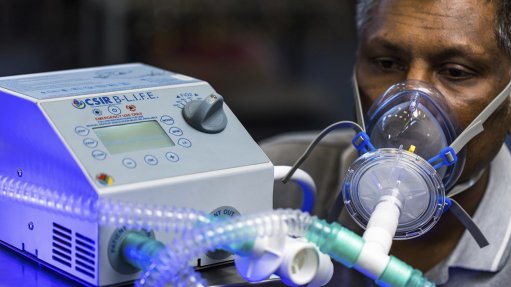
The world has gone through rapid transformation, created, in part, by the impact of Covid-19 and the sudden and radical dependance on digital technologies. Parallel to this, has been the ongoing exponential rise of the fourth industrial revolution, ushering in an era of new technologies, processes and ways of doing business.
The case of the first wholly locally produced ventilator
The CSIR’s Centre for Robotics and Future Production was able to leverage this digital transformation and the accompanying accelerated time to market in the production of ventilators, at a time when South Africa was experiencing severe challenges in coping with Covid-19.
Under the project name, CSIR L.I.F.E. (Lung Inspiratory Flow Enabler), the CSIR solution operates as a continuous positive airway pressure device that uses an innovative design to provide a mild level of oxygenated air pressure to keep the airways open and, thus, assist with breathing. The units are non-invasive (applied to the face and not inserted into the airway) and fulfil a need for a breathing apparatus that is ready to use, easily applied – even outside of hospitals if needs be – for patients who are at an early stage of respiratory difficulty caused by the coronavirus. It is not for use for non-Covid-19-related oxygenation.
Development started in early 2020 when the first cases of Covid-19 hit South Africa and the state of disaster was declared. The project formed part of government’s National Ventilator Project under the auspices of the Department of Trade, Industry and Competition, supported by the Solidarity Fund.
In the space of four months, in collaboration with multiple partners, the extended team was able to design, develop, test, license and produce 2 000 ventilators, using an advanced product lifecycle management (PLM) approach. A month later, production capacity was up to 8 000 units.
One of the enablers for such a rapid response was that documentation could be provided in digital formats, enabling a rigorous, documented product lifecycle methodology that would ensure scalable manufacturing, as well as compliance and licensing under the South African Health Products Regulatory Authority and guidelines of the World Health Organization. PLM software was used to facilitate rapid production scaling. The suite included components for systems engineering processes, computer-aided design tools, manufacturing execution tools, as well as quality management solutions that would ensure compliance with health product regulations for certification. Using a digital product lifecycle design methodology also ensured that the product could be manufactured in a large, scalable virtual factory environment by combining multiple factories with different capabilities to produce large volumes.
Working in a virtual factory
An obvious prerequisite for the design and manufacturing approach was that the capability had to be scalable to respond to the high numbers of ventilators needed. Furthermore, working amid lockdown regulations made contracting and procurement procedures more challenging, while, at the same time, it was clear from rising Covid-19 numbers that time was of the essence. Many design, testing and manufacturing processes, which would normally run sequentially, had to run in parallel.
Riaan Coetzee, research group leader for future production systems and project manager explains: “Initially, we thought a major obstacle would be obtaining components, since travel restrictions impacted the global supply chain – which was why we had health product import shortages to begin with.”
“However, it created the opportunity to work with local partners of different sizes across the country and, eventually, localise the manufacturing of a large percentage of the required parts. This is an important outcome for the manufacturing sector. The CSIR places great emphasis on partnerships, localising technology, reindustrialising our economy and, ultimately, becoming more competitive,” he adds.
Digital lifecycle management addressed the time challenges presented by the many processes and linkages between processes to understand the influencing factors and the reality of multiple planning iterations. All planning, mapping and even simulation and testing were done digitally before developing the physical product. Cost savings were possible because the digital methodology obviated the need to set up a plant first, and all production optimisation could be done virtually – many activities ran concurrently. Digital lifecycle management also enabled the team to identify which other entities to bring on board to speed up design, manufacturing and the regulatory approval process – resulting in a virtual factory.
In the end, only two factory visits were necessary, and more than 1 000 teleconferences during the 60- to 80-hour work weeks served to emphasise the benefit – and enabling ability – of digital transformation.
Coetzee says: “The project demonstrates the value of a digital product approach for South Africa. Adoption of fourth industrial revolution technologies has not been as rapid locally as it has been in other countries. Digital is the way to go.”
Other benefits of the digital approach include that it is scalable, depending on the size of project, and that it can be easily replicated.
By design, this approach is inclusive, allowing multiple design, production, quality software solutions to feed into one true digital backbone. Workflows, standards and guided execution make it easy to undertake practical, on-the-job training.
Coetzee adds: “The Covid-19 restrictions emphasised the benefit of digital manufacturing in that collaboration is possible without co-location. In this digital environment, all skills are immediately accessible, regardless of where they are physically based.”